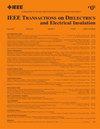Two-Dimensional Charge Characteristics in HVDC GIL Insulators: A Simulation Study
IF 3.1
3区 工程技术
Q2 ENGINEERING, ELECTRICAL & ELECTRONIC
IEEE Transactions on Dielectrics and Electrical Insulation
Pub Date : 2025-02-20
DOI:10.1109/TDEI.2025.3544165
引用次数: 0
Abstract
The long-term synergistic effects of high-voltage direct current (HVDC) and temperature gradients inevitably stimulate charge accumulation in gas-insulated transmission line (GIL) insulators, which significantly increases the risk of insulation failure. Due to the limitations in charge measurement techniques, it is crucial to develop effective methods for accurately simulating and evaluating the dynamic charge behaviors of GIL insulators under complex operating conditions. In this study, we present a 2-D bipolar charge transport and interaction (2-D BCTI) model that accounts for both space charge and surface charge dynamics. Such a model is employed to investigate the charge behaviors of HVDC GIL insulators under varying electric fields, polarization time, and voltage polarities. Our findings indicate that higher voltages and extended polarization time lead to increased charge migration and localized accumulation within the insulator. Further analysis reveals that the surface potential at the high-voltage terminal interface is predominantly influenced by the tangential current (高压直流GIL绝缘子二维电荷特性的仿真研究
高压直流(HVDC)和温度梯度的长期协同作用不可避免地刺激气体绝缘输电线路(GIL)绝缘子中的电荷积累,从而显著增加绝缘失效的风险。由于电荷测量技术的局限性,开发有效的方法来准确模拟和评估GIL绝缘子在复杂工作条件下的动态电荷行为是至关重要的。在这项研究中,我们提出了一个二维双极电荷传输和相互作用(二维BCTI)模型,该模型同时考虑了空间电荷和表面电荷动力学。利用该模型研究了高压直流GIL绝缘子在不同电场、极化时间和电压极性下的电荷行为。我们的研究结果表明,较高的电压和延长的极化时间导致绝缘体内电荷迁移和局部积累增加。进一步分析表明,高压端子界面处的表面电位主要受沿绝缘子表面的切向电流(${J}_{\text {s}}$)和通过绝缘子的大电流(${J}_{\text {v}}$)的影响。在盆绝缘子的其他区域,如屏蔽环和接地端子,${J}_{\text {s}}$是主导因素。该研究为研究表面电荷与空间电荷之间的相互作用提供了有价值的理论见解,为优化高压直流GIL系统的绝缘设计提供了基础。
本文章由计算机程序翻译,如有差异,请以英文原文为准。
求助全文
约1分钟内获得全文
求助全文
来源期刊
CiteScore
6.00
自引率
22.60%
发文量
309
审稿时长
5.2 months
期刊介绍:
Topics that are concerned with dielectric phenomena and measurements, with development and characterization of gaseous, vacuum, liquid and solid electrical insulating materials and systems; and with utilization of these materials in circuits and systems under condition of use.

 求助内容:
求助内容: 应助结果提醒方式:
应助结果提醒方式:


